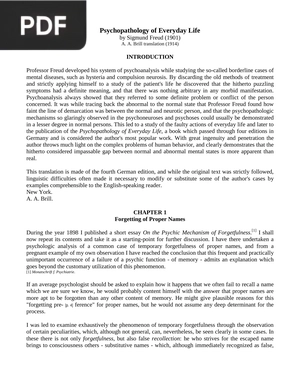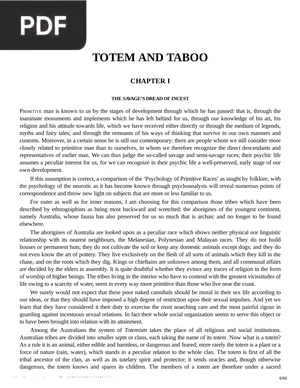The Interpretation of Dreams
Author: Sigmund Freud
*Wait a few seconds for the document to load, the time may vary depending on your internet connection. If you prefer, you can download the file by clicking on the link below.
Information
Description: <p>For many, this is the book that determined the beginning of psychoanalysis. In <strong>The Interpretation of Dreams</strong> Freud puts forward the theory that our dreams may be the way in which our non-conscious thoughts emerge to our consciousness, through messages emitted with the use of symbols.</p> <p>In this case dreams would be the manifestation of repressed desires that come to light when we sleep.</p> <p>In this work Freud presented a mechanism to be able to interpret the images and contents. It was also in this work that the concept of the «ego» appears for the first time.</p>
Pages: 491
Megabytes: 2.26 MB
This may interest you
Psychopathology of Everyday Life
Extension: PDF | 100 pages
<p>Freudian theory deals with the origin of the symptoms of serious mental pathologies and, at the same time, tries to explain the essential psychological mechanisms behind the actions of human beings in general.</p> <p>In <strong>Psychopathology of Everyday Life</strong>, Freud explains how, in his opinion, the functioning of our unconscious generates the appearance of small inconsistencies in our behavior: lapses, confused words and, in general, what the psychoanalyst called failed acts. He also explains the possible failures in the functioning of the human psyche that, from his perspective, could be behind these phenomena.</p>
Three Essays on the Theory of Sexuality
Extension: PDF | 83 pages
<p><strong>Three Essays on the Theory of Sexuality</strong> is considered one of Freud’s most relevant texts, since it embodies the concepts that make up the Freudian theory of psychosexual development.</p> <p>This group of three essays is very interesting and useful to comprehensively understand the legacy of the creator of psychoanalysis.</p> <p>Freud used the theme of sexuality as the center of all psychological gear, which caused serious differences with several of his colleagues.</p>
Delusion and Dream in Jensen’s Gradiva
Extension: PDF | 67 pages
<p>Sigmund Freud wrote <strong>Delusion and Dream in Jensen’s Gradiva</strong> in 1906 and it was published in May 1907. It can be regarded as his interpretation of the 1903 novel Gradiva by the German writer Wilhelm Jensen, which the psychiatrist Carl Gustav Jung recommended to Freud.</p> <p>In this novel, a young man named Norbert Hanold, while visiting a museum, is struck by the beauty of a bas-relief of a young Roman girl, whom he calls “Gradiva”. As the days go by, his thoughts are invaded by the image of this woman, dreaming of her and becoming obsessed with the idea of meeting her.</p> <p>It is believed that the reason for Jung’s recommendation to Freud is based on the fact that Gradiva deals with the subject of dreams, and it is well known that the Austrian psychoanalyst was interested in the role of dreams in the psyche of people, as he shows in The Interpretation of Dreams.</p>
Notes upon a Case of Obsessional Neurosis (the Rat Man case history)
Extension: PDF | 68 pages
<p>In October 1909, Freud published in Germany <strong>Notes upon a Case of Obsessional Neurosis</strong>, also known as the Rat Man case history, a nickname Freud gave him because the patient suffered from nightmares related to rats.</p> <p>The intention of the publication of this work was to demonstrate that psychoanalysis could indeed achieve effective therapeutic results (or so he stated), being under pressure since he had previously been unable to publish any successful results of psychoanalysis. In this way, he was finally able to demonstrate to the world his therapeutic capabilities.</p> <p>The patient, whose identity is still speculated today, was in treatment for about 6 months starting in October 1907. It is worth mentioning that the first 3 months the treatment was regular and daily, and the second trimester was sporadic and irregular.</p>
Totem and Taboo: Resemblances between the Psychic Lives of Savages and Neurotics
Extension: PDF | 69 pages
<p><strong>Totem and Taboo</strong> is a book out of the ordinary among Freud’s works. In it, the Viennese physician deals with historically rooted cultural and social phenomena. It covers topics related to religion, rituals and archeology.</p> <p>It is a book of great interest in the anthropological field, since in essence the book tries to explain the origins of the human species through psychoanalytic interpretations.</p>











































